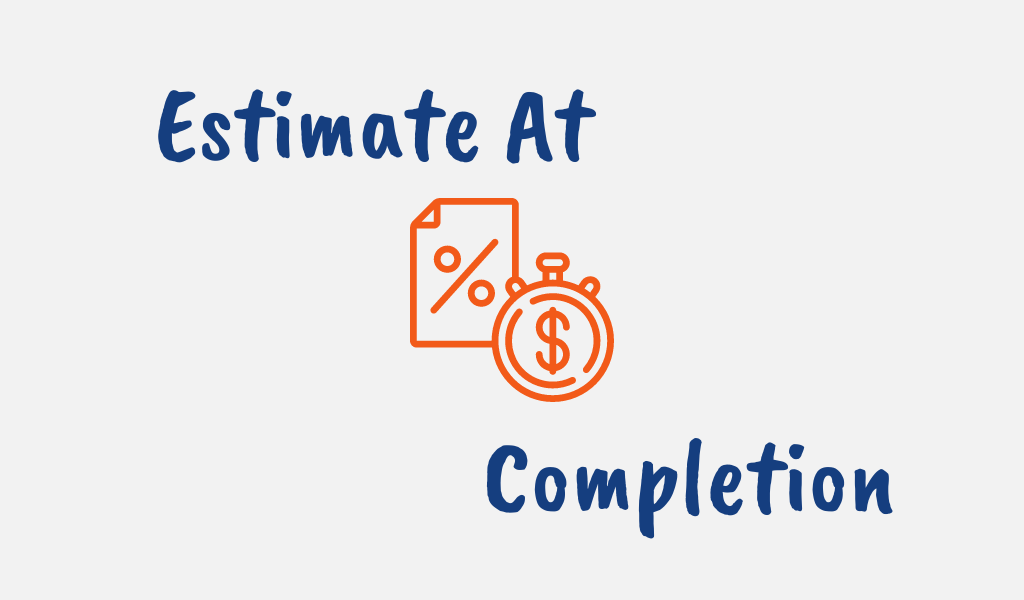No matter how much effort you put into planning a project, it can encounter unexpected changes that impact its budget, timeline, and scope.
Estimate at Completion (EAC) is a vital project management formula and metric that forecasts the total expected cost of a project that is being executed based on its current performance.
In this post, we’ll cover what Estimate at Completion in project management is all about, including EAC formulas, how to calculate EAC, and an example for clarity. We’ll also provide tips on answering questions on this topic in the PMP exam.
What is Estimate at Completion (EAC) in Project Management?
Estimate at Completion (EAC) is an Earned Value Management (EVM) formula used in project management to forecast the total expected expenditure to deliver a project based on its current performance.
It provides a realistic projection of the total budget needed and early warning of potential cost overruns which is key for monitoring and controlling project costs when unplanned events occur.
The EAC calculation adds the actual costs incurred so far to the estimated costs needed to complete the remaining work and incorporates unexpected changes in scope, delays, or variance from the baseline timeline and costs.
By comparing the EAC to the original Budget at Completion (BAC) you get an indication of whether your project is under or over budget.
Recalculating the EAC at intervals enables tracking of cost performance so corrective actions can be implemented when required.

Importance of Estimate at Completion in Project Management
Calculating and using the Estimate at Completion in your projects is important in many ways.
These include:
Enables Informed Decision Making
EAC provides a realistic total projected budget to help plan and allocate resources accordingly.
Comparing the EAC to the original Budget at Completion (BAC) highlights any variance from the initial estimated costs.
Armed with this information, you can determine if and how to adjust the timeline, staffing, or budgeted spending to get your project back on track.
Allows Early Intervention
Recalculating EAC at regular intervals enables the early detection of potential cost overruns while there is still time to intervene.
EAC alerts to emerging issues while they are still manageable, allowing you to implement corrective actions to avoid going over budget.
Improves Cost Control
EAC offers clear visibility into current cost performance against the project plan. It helps identify where efficiencies can be gained to optimize expenses which allows proactive budget realignment and resource allocation to keep costs contained.
Supports Earned Value Management
EAC is a key input for earned value management analysis. It enables assessing schedule and cost variances to performance baselines which highlights the health of budget utilization and timelines.
Allows Progress Monitoring
Comparing EAC forecasts over time demonstrates the project’s cost-efficiency trend which allows tracking of progress and performance to meet objectives.

Estimate at Completion Formulas
There are several formulas to calculate Estimate at Completion (EAC) depending on the project situation.
Selecting the appropriate EAC formula provides the most accurate forecast of total expected project costs. These formulas are:
1. EAC = AC + ETC
This simple formula sums the Actual Costs (AC) spent so far and the Estimated Costs to Complete (ETC) the remaining work.
It assumes future cost patterns will align with the plan. This formula is best used when the original budget estimate is inaccurate.
2. EAC = AC + (BAC – EV)
This formula adjusts the remaining Budget at Completion (BAC) by the Earned Value (EV) achieved to date.
It assumes future variance from the budget will differ from current performance. The best scenario to use this formula is when your project is not running smoothly.
3. EAC = AC + (BAC – EV) / (CPI x SPI)
This formula factors the Cost Performance Index (CPI) and Schedule Performance Index (SPI) to estimate the impact of current efficiency on total costs.
It is best used when delays or poor cost control have impacted the schedule and budget.
4. EAC = BAC / CPI
This is the most commonly used formula for EAC. It divides the total Budget at Completion (BAC) by the CPI ratio and assumes the current cost performance will continue through project completion.
It’s best used for projects on schedule with minor variances.

How to Calculate Estimate at Completion in 8 Steps
Follow these steps to calculate Estimate at Completion (EAC):
1. Determine the Budget at Completion (BAC) for the project.
- Add up all estimated costs for labor, materials, equipment, etc.
- The total is the approved budget.
2. Calculate the Cost Performance Index (CPI).
- Use the formula: CPI = Earned Value (EV) / Actual Cost (AC)
- The CPI ratio indicates cost efficiency.
3. Decide which EAC formula to use.
- If the project is on schedule with minor variances, use: EAC = BAC / CPI
- If the initial budget estimate was inaccurate, use: EAC = AC + ETC
- If the project is not progressing smoothly, use: EAC = AC + (BAC – EV)
4. Gather key data points for the formula:
- BAC – Total approved budget
- AC – Actual costs incurred so far
- EV – Earned value work completed
- ETC – Estimated costs to finish remaining work
5. Input data into the selected EAC formula and calculate.
6. Compare the EAC result to the BAC.
- If the EAC is lower, the project is under budget.
- If the EAC is higher, the project is forecasted to go over budget.
7. Take corrective actions as needed:
- Adjust resources or spending if the EAC is too high.
- Re-baseline the budget if the initial costs were inaccurate.
8. Recalculate EAC at regular intervals and track for trends.
Estimate at Completion Example
Let’s walk through an Estimate at Completion (EAC) example to demonstrate the importance of EAC in forecasting final project costs to maintain budget control:
A project has a Budget at Completion (BAC) of $100,000. The project is 4 months in out of a 12-month schedule.
The Earned Value (EV) to date is $30,000. While the Actual Costs (AC) spent so far is $40,000.
To calculate EAC using the formula:
EAC = BAC / CPI
First, we need to determine the Cost Performance Index (CPI). Use the formula:
CPI = EV / AC
Plug in the amounts:
CPI = $30,000 / $40,000 = 0.75
This CPI of 0.75 indicates the project is currently over budget.
Now calculate the EAC:
EAC = $100,000 / 0.75 = $133,333
Given the current cost overrun, the EAC of $133,333 exceeds the original $100,000 BAC.
As a project manager, you can then use this data to reduce expenses and get costs back on track before the overrun grows.

Estimate at Completion (EAC) vs Estimate to Complete (ETC)
Estimate at Completion (EAC) and Estimate to Complete (ETC) are two valuable forecasts used in project management, but they measure different aspects:
- EAC estimates the total expected project cost at completion.
- ETC estimates the additional budget needed to finish the remaining work.
EAC calculates the total cost by adding up:
- Actual costs (AC) incurred so far
- Plus estimated remaining costs (ETC)
Conversely, ETC only considers the forecasted expenses still needed. While EAC factors in both previous and future spending, ETC only looks ahead.
EAC provides a big-picture view of the total projected budget given current performance. This allows for assessing the cost impact of deviations.
ETC narrows the focus to the anticipated costs to complete outstanding tasks and finish the project. This helps allocate the proper resources to the remaining work.
Another key difference is that while EAC is compared against the original Budget at Completion (BAC) to determine variance, ETC does not consider BAC.
Estimate at Completion (EAC) vs To Complete Performance Index (TCPI)
Estimate at Completion (EAC) and To Complete Performance Index (TCPI) are two important metrics for forecasting project costs.
There are key distinctions between both of them:
- The EAC estimates the total expected cost of the entire project at completion, while the TCPI measures the cost performance needed on remaining work to meet the budget.
- EAC calculates a projection based on performance up to the current date. It helps determine if the total budget is still feasible. TCPI on the other hand calculates the CPI required moving forward to achieve the original or revised budget and identifies if the remaining work is realistic.
- EAC provides a forecast based on actuals, while TCPI sets a cost-efficiency target for future work.
- EAC is reactive, adjusting the total estimate based on what has occurred. Conversely, TCPI is proactive, dictating the performance level required going forward.
- Project managers use EAC to assess if the Budget at Completion (BAC) is still viable and take corrective actions if needed. They use TCPI to set goals for controlling costs to completion.
Together, EAC and TCPI provide past and future perspectives to manage project costs effectively. EAC evaluates the current path, while TCPI charts the optimum path ahead.

Estimate at Completion PMP Exam Tips
Acing questions on Estimate at Completion (EAC) is key to passing the Project Cost Management knowledge area on the PMP certification exam.
EAC forecasts total expected project costs based on performance to date. Understanding how to calculate, interpret, and apply EAC provides crucial competency.
The following tips help master EAC for your PMP exam:
1. Know the EAC formulas and when each applies based on the project situation.
2. Understand how EAC provides total budget forecasts to control project costs.
3. Study the key EAC inputs:
- Budget at Completion (BAC)
- Actual Costs (AC)
- Earned Value (EV)
- Estimate to Complete (ETC)
- Cost Performance Index (CPI)
4. Recognize the difference between EAC vs Estimate to Complete (ETC). It is important to understand that EAC estimates the total cost based on the current project performance, while ETC estimates the remaining costs.
5. Know how to compare EAC to the original BAC to determine variances and whether the forecast is over/under budget.
6. Know how to calculate CPI and interpret the ratio.
7. Review EAC calculation examples using simulated project data.
8. Understand how EAC guides decisions on corrective actions and adjustments.
Conclusion
As a project manager, regularly estimating total costs is crucial to staying on budget. Calculating the Estimate at Completion at intervals provides the data needed to evaluate the project performance against what was planned.
Comparing EAC against the original budget baseline quickly reveals any emerging variance. This insight enables timely corrective actions such as realigning resources, adjusting scope or timelines, and reducing expenses.
As changes occur, updating the EAC re-forecasts the total expected costs. Having realistic projections throughout empowers informed decision-making.





